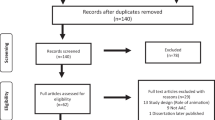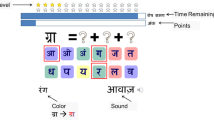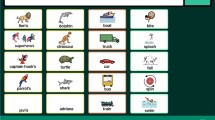Abstract
The aim of this study was to compare the efficacy with which the use of a speech generating device (Apple iPadTM with GoTalk NowTM application) versus a communication board promoted the production of two-symbols combinations (agent-action and attribute-entity combinations) by children limited speech within a shared story reading context. Four children between the ages of 6;8 (years; months) and 11;4 with severe motor speech disorders and a variety of developmental disabilities participated in the study. An adapted alternating treatment design was used. All four participants showed increased production of two-symbol combinations in both intervention conditions. The Wilcoxon ranked pairs test did not show differences between the conditions for any participant. The results suggest that symbol combination skills can effectively be taught using either AAC system. A preference assessment indicated that all participants preferred to use the speech generating device during shared story reading.

Similar content being viewed by others
Notes
iPod and iPad are registered trademarks of Apple Inc., Cupertino, CA.
The GoTalk Now application is sold by Attainment Company, Verona, WI.
The Junior phase in primary school refers to the first three years of official schooling (Grades 1–3).
The Special stream at this particular school made use of a modified curriculum with assessment standards that were lower than those of the national school curriculum.
References
Bates, E., Dale, P. S., & Thal, D. (1995). Individual differences and their implications for theories of language development. In P. Fletcher & B. MacWhinney (Eds.), Handbook of child language (pp. 96–151). Oxford: Basil Blackwell.
Beck, A. R., Stoner, J. B., Bock, S. J., & Parton, T. (2008). Comparison of PECS and the use of a VOCA: a replication. Education and Training in Developmental Disabilities, 43(2), 198–216.
Binger, C., & Light, J. (2007). The effect of aided AAC modeling on the expression of multi-symbol messages by preschoolers who use AAC. Augmentative and Alternative Communication, 23(1), 30–46. doi:10.1080/07434610600807470.
Binger, C., & Light, J. (2008). The morphology and syntax of individuals who use AAC: research review and implications for effective practice. Augmentative and Alternative Communication, 24(2), 123–138. doi:10.1080/07434610701830587.
Binger, C., Kent-Walsh, J., Berens, J., Del Campo, S., & Rivera, D. (2008). Teaching Latino parents to support the multi-symbol message productions of their children who require AAC. Augmentative and Alternative Communication, 24(4), 323–38. doi:10.1080/07434610802130978.
Binger, C., Kent-Walsh, J., Ewing, C., & Taylor, S. (2010). Teaching educational assistants to facilitate the multisymbol message productions of young students who require augmentative and alternative communication. American Journal of Speech-Language Pathology, 19(2), 108–120. doi:10.1044/1058-0360(2009/09-0015).
Blackstone, S. W., Williams, M. B., & Wilkins, D. P. (2007). Key principles underlying research and practice in AAC. Augmentative and Alternative Communication, 23(3), 191–203. doi:10.1080/07434610701553684.
Bock, S. J., Stoner, J. B., Beck, A. R., Hanley, L., & Prochnow, J. (2005). Increasing functional communication in non-speaking preschool children: comparison of PECS and VOCA. Education and Training in Developmental Disabilities, 40(3), 264–278.
Boesch, M. C., Wendt, O., Subramanian, A., & Hsu, N. (2013). Comparative efficacy of the picture exchange communication system (PECS) versus a speech-generating device: effects on requesting skills. Research in Autism Spectrum Disorders, 7(3), 480–493. doi:10.1016/j.rasd.2012.12.002.
Bortz, M. (1997). South African language assessments. Ponteland: STASS Publications.
Brekke, K. M., & Von Tetzchner, S. (2003). Co-construction in graphic language development. In S. Von Tetzchner & N. Grove (Eds.), Augmentative and alternative communication: developmental issues (pp. 176–210). London: Whurr.
Brown, R. (1973). A first language: the early stages. London: George Allen & Unwin.
Bruno, J., & Trembath, D. (2006). Use of aided language stimulation to improve syntactic performance during a weeklong intervention program. Augmentative and Alternative Communication, 22(4), 300–13. doi:10.1080/07434610600768318.
Cannella-Malone, H. I., DeBar, R. M., & Sigafoos, J. (2009). An examination of preference for augmentative and alternative communication devices with two boys with significant intellectual disabilities. Augmentative and Alternative Communication, 25, 262–273. doi:10.3109/07434610903384511.
Carrow-Woolfolk, E. (1999). Test for auditory comprehension of language (4th ed.). Austin: Pro-Ed.
Dada, S. (1999). Teachers’ attitudes towards children with LNFS using two AAC devices (Master's thesis). Retrieved from http://upetd.up.ac.za/thesis/available/etd-08022006-142253/. Accessed 27 Oct 2014.
Dada, S., & Alant, E. (2002). A comparative study of the attitudes of teachers at special and educationally inclusive schools towards learners with little or no functional speech using communication devices. South African Journal of Education, 22(3), 213–218.
Dada, S., Huguet, A., & Bornman, J. (2013). The iconicity of picture communication symbols for children with English additional language and mild intellectual disability. Augmentative and Alternative Communication, 29(4), 360–73. doi:10.3109/07434618.2013.849753.
Dowden, P. (1997). Augmentative and alternative communication: decision making for children with severely unintelligible speech. Augmentative and Alternative Communication, 13, 48–58.
Dunn, L. M., & Dunn, D. M. (2007). Peabody picture vocabulary test (4th ed.). San Antonio: Pearson.
Fitzgerald, E. (1959). Straight language for the deaf. Washington: The Volta Bureau.
Flores, M., Musgrove, K., Renner, S., Hinton, V., Strozier, S., Franklin, S., & Hil, D. (2012). A comparison of communication using the Apple iPad and a picture-based system. Augmentative and Alternative Communication, 28(2), 74–84. doi:10.3109/07434618.2011.644579.
Garg, M., & Singhal, R. (2014). Speech re-synthesis from spectrogram image through sinusoidal modelling. In Advances in computing, communications and informatics (ICACCI, 2014 international conference) (pp. 2757–2761). Delhi: Institute of Electrical and Electronic Engineers.
Gevarter, C., O’Reilly, M. F., Rojeski, L., Sammarco, N., Lang, R., Lancioni, G. E., & Sigafoos, J. (2013). Comparing communication systems for individuals with developmental disabilities: a review of single-case research studies. Research in Developmental Disabilities, 34(12), 4415–4432. doi:10.1016/j.ridd.2013.09.017.
Goossens, C. (1989). Aided communication intervention before assessment: a case study of a child with cerebral palsy. Augmentative and Alternative Communication, 5, 14–26. doi:10.1080/07434618912331274926.
Henton, C. (2012). Text‐to‐speech synthesis development. The Encyclopedia of Applied Linguistics. Wiley Online Library. doi:10.1002/9781405198431.wbeal1207.
Higginbotham, D. J., & Engelke, C. R. (2013). A primer for doing talk-in-interaction research in augmentative and alternative communication. Augmentative and Alternative Communication, 29(1), 3–19. doi:10.3109/07434618.2013.767556.
Horn, T. (2014). Children’s attitudes towards interaction with an unfamiliar peer with little or no functional speech: Comparing high- and low-technology devices (Master's thesis). Retrieved from http://repository.up.ac.za/handle/2263/42056. Accessed 9 Feb 2015.
Kaufman, A. S., & Kaufman, N. L. (2004). Kaufman Brief Intelligence Test (2nd ed.). San Antonio: Pearson.
Kent-Walsh, J., & McNaughton, D. (2005). Communication partner instruction in AAC: present practices and future directions. Augmentative and Alternative Communication, 21(3), 195–204. doi:10.1080/07434610400006646.
Koul, R. (2003). Synthetic speech perception in individuals with and without disabilities. Augmentative and Alternative Communication, 19(1), 49–58. doi:10.1080/0743461031000073092.
Light, J., & Drager, K. (2007). AAC technologies for young children with complex communication needs: state of the science and future research directions. Augmentative and Alternative Communication, 23(3), 204–16. doi:10.1080/07434610701553635.
Light, J. C., Parsons, A. R., & Drager, K. (2002). “There’s more to life than cookies”. Developing interactions for social closeness with beginning communicators who use AAC. In J. Reichle, D. R. Beukelman, & J. C. Light (Eds.), Exemplary pratices for beginning communicators: Implications for AAC (pp. 187–218). Baltimore: Paul H. Brookes.
NCSS. (2012). Computer software. Kaysville: NCSS LLC.
Nigam, R., Schlosser, R. W., & Lloyd, L. L. (2006). Concomitant use of the matrix strategy and the mand-model procedure in teaching graphic symbol combinations. Augmentative and Alternative Communication, 22(3), 160–77. doi:10.1080/07434610600650052.
Parker, R. I., & Vannest, K. (2009). An improved effect size for single-case research: nonoverlap of all pairs. Behavior Therapy, 40(4), 357–67. doi:10.1016/j.beth.2008.10.006.
Quist, R., & Lloyd, L. L. (1997). Principles and uses of technology. In L. L. Lloyd, D. R. Fuller, & H. H. Arvidson (Eds.), Augmentative and alternative communication: a handbook of principles and practices (pp. 107–126). Needham Heights: Allyn & Bacon.
Romski, M. A., & Sevcik, R. A. (1988). Augmentative and alternative communication systems: considerations for individuals with severe intellectual disabilities. Augmentative and Alternative Communication, 4(2), 83–93. doi:10.1080/07434618812331274667.
Romski, M. A., & Sevcik, R. A. (1996). Breaking the speech barrier: language development through augmented means. Baltimore: Paul H. Brookes.
Romski, M. A., Sevcik, R. A., & Adamson, L. B. (1997). Framework for studying how children with developmental disabilities develop language through augmented means. Augmentative and Alternative Communication, 13(3), 172–178. doi:10.1080/07434619712331277988.
Schlosser, R. W. (2003). Roles of speech output in augmentative and alternative communication: narrative review. Augmentative and Alternative Communication, 19(1), 5–27. doi:10.1080/0743461032000056450.
Sigafoos, J., O’Reilly, M. F., Ganz, J. B., Lancioni, G. E., & Schlosser, R. W. (2005). Supporting self-determination in AAC interventions by assessing preference for communication devices. Technology and Disability, 17, 143–153.
Sigafoos, J., Green, V. A., Payne, D., & Son, S. (2009). A Comparison of picture exchange and speech-generating devices: acquisition, preference, and effects on social interaction. Augmentative and Alternative Communication, 25, 99–109. doi:10.1080/07434610902739959.
Son, S., Sigafoos, J., O’Reilly, M. F., & Lancioni, G. E. (2006). Comparing two types of augmentative and alternative communication systems for children with autism. Pediatric Rehabilitation, 9(4), 389–385. doi:10.1080/13638490500519984.
Soto, G., & Seligman-Wine, J. (2003). Child-driven development of alternative communciation: a case study. In S. Von Tetzchner & N. Grove (Eds.), Augmentative and alternative communication: developmental issues (pp. 211–228). London: Whurr.
Sutton, A., Soto, G., & Blockberger, S. (2002). Grammatical issues in graphic symbol communication. Augmentative and Alternative Communication, 18, 192–204.
Tönsing, K. M., Dada, S., & Alant, E. (2014). Teaching graphic symbol combinations to children with limited speech during shared story reading. Augmentative and Alternative Communication, 30(4), 279–97. doi:10.3109/07434618.2014.965846.
Van der Meer, L., Sigafoos, J., O’Reilly, M. F., & Lancioni, G. E. (2011). Assessing preferences for AAC options in communication interventions for individuals with developmental disabilities: a review of the literature. Research in Developmental Disabilities, 32, 1422–31. doi:10.1016/j.ridd.2011.02.003.
Van der Meer, L., Kagohara, D., Roche, L., Sutherland, D., Balandin, S., Green, V. A., & Sigafoos, J. (2013). Teaching multi-step requesting and social communication to two children with autism spectrum disorders with three AAC options. Augmentative and Alternative Communication, 29(3), 222–234. doi:10.3109/07434618.2013.815801.
Wetherby, A. M., Watt, N., Morgan, L., & Shumway, S. (2007). Social communication profiles of children with autism spectrum disorders late in the second year of life. Journal of Autism and Developmental Disorders, 37, 960–975. doi:10.1007/s10803-006-0237-4.
Wilcoxon, F. (1945). Individual comparisons by ranking methods. Biometrics Bulletin, 1(6), 80–83.
Wolery, W., Gast, D. L., & Hammond, D. (2010). Comparative intervention designs. In D. Gast (Ed.), Single subject research methodologies in behavioral sciences (pp. 329–381). New York: Routledge.
Acknowledgments
This research project was funded by the National Research Foundation (NRF) of South Africa and the Research Development Programme from the University of Pretoria. Opinions expressed and conclusions arrived at, are those of the author and are not necessarily to be attributed to the NRF or the University of Pretoria. The author would like to thank the children, their families, and the school staff for making the study possible.
Conflict of Interest
The author reports no conflict of interest. The author alone is responsible for the content and writing of this paper.
Author information
Authors and Affiliations
Corresponding author
Appendix
Appendix
Arrangement of Symbols on Communication Boards and GoTalk Now Pages

Rights and permissions
About this article
Cite this article
Tönsing, K.M. Supporting the Production of Graphic Symbol Combinations by Children with Limited Speech: A Comparison of Two AAC systems. J Dev Phys Disabil 28, 5–29 (2016). https://doi.org/10.1007/s10882-015-9425-5
Published:
Issue Date:
DOI: https://doi.org/10.1007/s10882-015-9425-5




